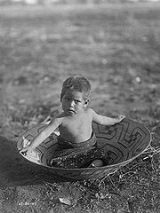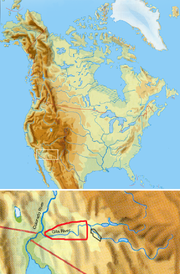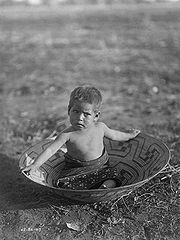
Maricopa
Encyclopedia

Native Americans in the United States
Native Americans in the United States are the indigenous peoples in North America within the boundaries of the present-day continental United States, parts of Alaska, and the island state of Hawaii. They are composed of numerous, distinct tribes, states, and ethnic groups, many of which survive as...
, who live in the Salt River Pima-Maricopa Indian Community
Salt River Pima-Maricopa Indian Community
The Salt River Pima–Maricopa Indian Community comprises two distinct Native American tribes—the Pima and the Maricopa —many of whom were originally of the Halchidhoma tribe. The community was officially created by an Executive Order of US President Rutherford B. Hayes on June 14, 1879...
and Gila River Indian Community
Gila River Indian Community
The Gila River Indian Community is an Indian reservation in the U.S. state of Arizona, lying adjacent to the south side of the city of Phoenix, within the Phoenix Metropolitan Area in Pinal and Maricopa Counties. It was established in 1859, and formally established by Congress in 1939...
along with the Pima
Pima
The Pima are a group of American Indians living in an area consisting of what is now central and southern Arizona. The long name, "Akimel O'odham", means "river people". They are closely related to the Tohono O'odham and the Hia C-ed O'odham...
, a tribe with whom the Maricopa have long held a positive relationship. The Maricopa, mostly Xalychidom Piipaash, at the Salt River Pima-Maricopa Indian Community
Salt River Pima-Maricopa Indian Community
The Salt River Pima–Maricopa Indian Community comprises two distinct Native American tribes—the Pima and the Maricopa —many of whom were originally of the Halchidhoma tribe. The community was officially created by an Executive Order of US President Rutherford B. Hayes on June 14, 1879...
are concentrated in Lehi
Lehi, Arizona
Lehi is a distinct community within Mesa, Arizona, which predates Mesa's own founding. Lehi was annexed into its much larger former neighbor in 1970, and now is the northern limit of central Mesa....
, while the Maricopa at the Gila River Indian Community
Gila River Indian Community
The Gila River Indian Community is an Indian reservation in the U.S. state of Arizona, lying adjacent to the south side of the city of Phoenix, within the Phoenix Metropolitan Area in Pinal and Maricopa Counties. It was established in 1859, and formally established by Congress in 1939...
are concentrated in Maricopa Colony
Maricopa Colony, Arizona
Maricopa Colony is a census-designated place in Maricopa County, Arizona, United States, located in the Gila River Indian Community. The population was 709 at the 2010 census.- Demographics :...
. The Maricopa were a former Yuma River group, living along the banks of the Colorado River
Colorado River
The Colorado River , is a river in the Southwestern United States and northwestern Mexico, approximately long, draining a part of the arid regions on the western slope of the Rocky Mountains. The watershed of the Colorado River covers in parts of seven U.S. states and two Mexican states...
.
Names
The neighboring Akimel O'odham and future allies, called them Kokmalik'op ('enemies in the big mountains'), and the Spanish rendered it as Maricopa. They call themselves Piipaa, Piipaash or Pee-Posh ('people'). Many descendants of the HalchidhomaHalchidhoma
The Halchidhoma are an Indian tribe now living mostly on the Salt River reservation, but formerly native to the area along the lower Colorado River in California and Arizona when first contacted by Europeans...
, which had sought refuge at the Maricopa in 1825, today identify themselves in English as Maricopa, although they could preserve their own identity and therefore call themselves Xalychidom Piipaa or Xalychidom Piipaash ('people who live toward the water').
History

Colorado River
The Colorado River , is a river in the Southwestern United States and northwestern Mexico, approximately long, draining a part of the arid regions on the western slope of the Rocky Mountains. The watershed of the Colorado River covers in parts of seven U.S. states and two Mexican states...
for centuries. In the 16th century, they migrated to the area around the Gila River
Gila River
The Gila River is a tributary of the Colorado River, 650 miles long, in the southwestern states of New Mexico and Arizona.-Description:...
, to avoid attacks by the Quechan
Quechan
The Quechan are a Native American tribe who live on the Fort Yuma Indian Reservation on the lower Colorado River in Arizona and California just north of the border with Mexico...
and Mojave peoples. During the 1840s, epidemics took a toll on the tribe. In the 19th century, the Maricopa formed a confederation with the Pima, and in 1857 they successfully defeated the Quechan and Mojave at Maricopa Wells. They became successful farmers, and in 1870, they produced three million pounds of wheat; however, drought and water diversion by non-Indians brought widespread crop failures.
In the 19th and the 20th centuries, the Bureau of Indian Affairs
Bureau of Indian Affairs
The Bureau of Indian Affairs is an agency of the federal government of the United States within the US Department of the Interior. It is responsible for the administration and management of of land held in trust by the United States for Native Americans in the United States, Native American...
implemented policies to try to assimilate the Maricopa into mainstream society, and they brought Presbyterian missionaries into the communities. In 1914, the US federal government broke tribal landholdings into individual allotments. The Pima Advisory Council was formed by the BIA in 1926 to speak on behalf of the Pima and Maricopa communities. In 1936 the Pimas and Maricopas agreed on a constitution to restore some measure of self-governance.
Through the 1930s, surface flow on the Gila River was reduced to nothing, and the tribe suffers greatly due to loss of their river; however, the BIA ignored water issues. The tribe resorted to using brackish well water, incapable of growing edible crops, so the tribe switched to growing cotton.
Language
Their heritage language is Maricopa languageMaricopa language
The Maricopa language is spoken by the Native American Maricopa tribe, on two reservations in Arizona: the Salt River Pima-Maricopa Indian Community and the Gila River Indian Community.-Grammar:...
, which belongs to the Yuman language family.
Arts
The Maricopa are known for their basket weaving and textiles, but in particular, they are known for their highly burnished red-on-redware pottery. Their traditional pottery practices enjoyed a revival from 1937 to 1940. A US Home Extension Agent, Elizabeth Hart works with a leading Maricopa pottery, Ida Redbird, formed the Maricopa Pottery Cooperative. Redbird served as president of the cooperative, which had 17 to 19 master potters as members. Hart encouraged members to sign their work. SwastikaSwastika
The swastika is an equilateral cross with its arms bent at right angles, in either right-facing form in counter clock motion or its mirrored left-facing form in clock motion. Earliest archaeological evidence of swastika-shaped ornaments dates back to the Indus Valley Civilization of Ancient...
s were a common traditional motif that was abandoned in the 1940s, due to the Nazi usurpation of the image. The paddle and anvil method of construction is used, and, while utilitarian cookware is tempered, decorative Maricopa pottery has no temper.
Notable Maricopa
- Ida Redbird (1892-1971) - Master potter of the Maricopa; instrumental in the 1937-1940 Maricopa pottery revival; first president of Maricopa Pottery Makers Association; translator and informantInformant (linguistics)An informant or consultant in linguistics is a native speaker who acts as a linguistic reference for a language being studied. The informant's role is that of a senior interpreter, who demonstrates native pronunciation, provides grammaticality judgments regarding linguistic well-formedness, and may...
for Leslie Spier’s Yuma Tribes of the Gila River, thus helping to preserve her American Indian heritage. - Robert "Tree" Cody, Native American flutist

